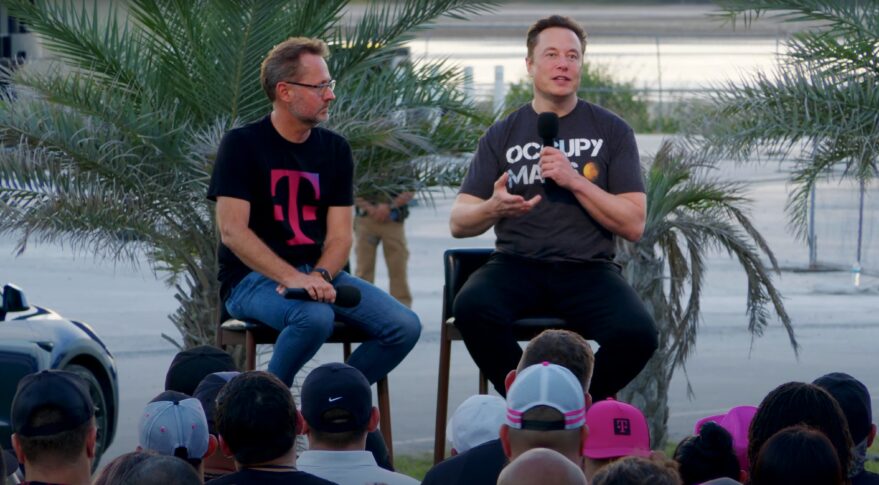
SpaceX and T-Mobile partner for direct-to-cellphone satellite service (Image Credit: Space News)
TAMPA, Fla. — T-Mobile announced plans Aug. 25 to use SpaceX’s Starlink broadband satellites next year to bring connectivity to phones beyond the reach of its cell towers in the United States.
Upgraded Starlink satellites would connect directly to standard cellphones under a technology partnership that aims to bring services to “mobile dead zones” across the country.
Beta services that would be initially limited to messages and pictures could begin “as soon as late next year,” T-Mobile CEO Mike Sievert said, with voice and data capabilities later coming at an unspecified time.
T-Mobile is contributing a slice of cellphone-ready nationwide spectrum as part of its partnership with SpaceX, which would beam the frequencies to phones from second-generation Starlink satellites using antennas roughly 25 square meters in size.
Starlink V2 satellites are too big to fit on a Falcon 9 that SpaceX has been using to launch its current generation of Starlinks, SpaceX CEO Elon Musk said, and need the super-heavy-lift Starship vehicle it is developing to get to low Earth orbit.
If the Starship program is “delayed longer than expected,” he said the company is considering initially downsizing second-generation satellites — “a sort of Starlink V2 mini” — so they would fit on a Falcon 9.
Musk did not specify whether a downsized Starlink V2 would have an antenna large enough to connect to mobile phones directly.
SpaceX first unveiled the plan to use a mix of Falcon 9 and Starship rockets for its Starlink V2 in an Aug. 19 letter to the Federal Communications Commission (FCC).
Regulatory obstacles
In June, the Federal Aviation Administration said SpaceX must implement dozens of measures to mitigate environmental effects before launching Starship to orbit from its Texas test site.
SpaceX also still needs permission from the FCC to operate the 30,000 Starlink V2 satellites in its proposed second-generation constellation.
Musk said “we are constrained by regulatory approval,” but “from a technical standpoint” its direct-to-cellphone service would work even with just a handful of Starlinks in orbit with large enough antennas — although there would be a lag in the service until it ramps up.
“We have it working in the lab and we’re confident this will work in the field,” he said.
According to Musk, the service will be capable of providing “maybe two to four megabits” of capacity, enabling 1,000-2,000 simultaneous voice calls or hundreds of thousands of text messages.
However, this capacity would be spread over a very large area.
“It’s not a substitute for ground cell stations,” Musk said, because those “especially in urban and suburban areas will definitely be superior to what we’re talking about here.
“This is really meant to provide basic coverage to areas that are currently completely dead.”
Starlink’s expansion into areas without wireless connectivity notably comes just weeks after the FCC denied it nearly $900 million in subsidies to expand its rural broadband services.
Satellite expansion
Sievert said their direct-to-cellphone service would also create a layer of redundancy for cellular networks in case cell towers get knocked out by natural disasters or other means.
While T-Mobile is not ready to announce a product yet, he said the company expects to include satellite-enabled nationwide coverage in its most popular mobile plans for free.
For the low-cost plans that don’t include it, he said “our aspiration is to charge a monthly service fee that will be far less than the monthly service fees charged by today’s satellite connectivity services.”
He said the companies plan to reach out to messaging app providers, such as Apple with its iMessage service, to include them in the service “right out the gate.”
The companies are also seeking partnerships with mobile providers internationally to forge reciprocal roaming alliances.
If a foreign carrier can find suitable spectrum in their country to participate in a roaming alliance, he said their customers could stay connected wherever they travel in the U.S, in return for giving U.S. customers the same capability in their country.
SpaceX and T-Mobile’s alliance threatens to disrupt startups AST SpaceMobile and Lynk Global, which are developing constellations that also aim to connect directly to unmodified phones.
Lynk Global has been looking to launch initial commercial services for its network before the end of this year, while AST SpaceMobile expects to deploy its first set of operational satellites in late 2023.
AST SpaceMobile’s BlueWalker 3 prototype is slated to launch in early to mid-September on a Falcon 9 with other passengers.








